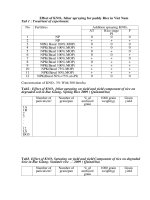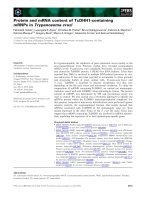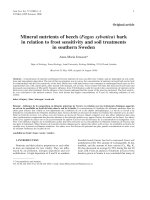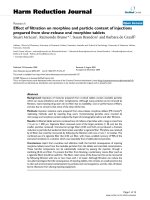Antinutrient and mineral content of thirteen different varieties of pearl millet locally grown in Haryana, India
Bạn đang xem bản rút gọn của tài liệu. Xem và tải ngay bản đầy đủ của tài liệu tại đây (194.98 KB, 8 trang )
Int.J.Curr.Microbiol.App.Sci (2017) 6(5): 2136-2143
International Journal of Current Microbiology and Applied Sciences
ISSN: 2319-7706 Volume 6 Number 5 (2017) pp. 2136-2143
Journal homepage:
Original Research Article
/>
Antinutrient and Mineral Content of Thirteen Different Varieties of
Pearl Millet Locally Grown in Haryana, India
Isha Kaushik* and Raj Bala Grewal
Centre of Food Science and Technology, CCSHAU, Hisar, Haryana, India
*Corresponding author
ABSTRACT
Keywords
Antinutrient,
Polyphenol,
Phytic acid,
Pearl millet
Article Info
Accepted:
19 April 2017
Available Online:
10 May 2017
Thirteen different varieties of pearl millet locally grown in Haryana were analyzed
for antinutrient content (polyphenol and phytic acid) and mineral content.
Significant variation was noticed among different varieties i.e., 403.7 to 521 mg
polyphenol/100 g and 577.7 to 620.7 mgphytic acid/100 g. Polyphenol and phytic
acid was found maximum in HHB-146 and HHB-67 and minimum content
observed in WHC-901-445 and HHB-226, respectively varieties of pearl millet.
Pearl millet varieties were also contained appreciable amount of mineral content
i.e., potassium, magnesium, calcium, iron, zinc and copper varied from 171.6 to
215.3, 64.1 to 72.0, 27.2 to 37.3, 2.7 to 6.4, 1.3 to 1.9 and 0.1 to 0.5 mg/100 g,
respectively. Different treatments such as soaking, fermentation, blanching and
roasting can enhance the bio-availability of these minerals by decreasing the level
of antinutrients. Therefore, knowledge of nutrient content of these locally grown
pearl millet varieties may help in the commercial processing of these grains into
value-added food and beverage products which can be an important driver for
economy and to curb malnutrition in developing countries.
Introduction
Pearl millet is small seeded grains, mainly
produced in tropical and semi-arid region in
India and Africa. It is underutilized and lesser
known crop with capability of growing in less
water areas on about 30 million ha in more
than 30 countries of five continents viz., Asia,
Africa, North America, South America, and
Australia. India is the largest producer of the
pearl millet in the world and its cultivation is
next to rice, maize and wheat. The major
pearl millet growing states in order of area are
Rajasthan, Maharashtra, Gujarat, Uttar
Pradesh and Haryana and these account for
87% of the total area under cultivation of
pearl millet (Rana et al., 2012). In Haryana,
production area under this crop during karif2014-15 was 383 hectare with total
production of 670 lakh tonnes and average
yield of 1749 kgs/ha (Anonymous, 2015). It is
cheap and economic crop of dual purpose
which is used as food for human, feed for
poultry birds and also dry as well as green
fodder for cattle. Pearl millet commonly
known as bajra and termed as “nutricereal”
due to rich source of energy, carbohydrate,
protein, fat and ash, besides, it is also a rich
source of dietary fiber and minerals (iron,
calcium, magnesium, potassium etc) (Abdalla
2136
Int.J.Curr.Microbiol.App.Sci (2017) 6(5): 2136-2143
et al., 2009). It is free from major
antinutrients but contains variable amount of
phytate and polyphenols and different
treatments such as soaking, fermentation,
blanching and roasting decrease the level of
these antinutrients (Eyzaguirre et al., 2006;
Hithamani & Srinivasan, 2014; Lestienne et
al., 2005). In developing countries, the
commercial processing of these locally grown
grains into value-added food and beverage
products can be an important driver for
economy and to curb malnutrition, therefore,
the objective of this study to analyze the
antinutrient and mineral content of thirteen
pearl millet varieties.
ml in 10 ml graduated test tube. The contents
were well mixed. Then, 0.5 ml Folin-Denis
reagent was added and the tubes were
thoroughly shaken. Exactly after 3 min., 1 ml
saturated sodium carbonate solution was
added and the tubes were thoroughly shaken
again and allowed to stand for 1 hr. The
absorbance was read at 725 nm using
methanolic-HCl as blank. If the solution was
cloudy or precipitates appeared, it was
centrifuged before readings were taken. A
standard curve was plotted by taking 0.5 ml to
4.0 ml of tannic standard solution containing
10 µg to 80 µg of tannic acid.
Materials and Methods
Pearl millet varieties viz., composite/desi
varieties (HC-10 and HC-20), improved
released variety (HHB-67), released hybrids
(HHB-146, HHB-197, HHB-223, HHB-226,
HHB-234 and HHB-272), white composite
variety (WHC-901-445), white seeded hybrid
(HMP-802 and HHB-256) and hybrid in
pipeline (HHB-265) were procured from the
Department of Genetics and Plant Breeding,
CCSHAU, Hisar.
The chemicals were procured from SigmaAldrich Chemicals Pvt. Ltd. New Delhi
(India) and Central Drug House (CDH), New
Delhi (India).
Anti-nutrient content of pearl millet
Polyphenols
The polyphenols were determined by the
method of Swain & Hills (1959). About 500
mg of defatted sample was refluxed with 50
ml methanol containing 1% HCl for 4 hr. The
extract was concentrated by evaporating
methanol on a boiling water bath and brought
its volume to 25 ml with methanolic-HCl. The
extract (1.5 ml) was diluted with water to 8.5
Where,
M = concentration of extract elute obtained
from standard graph
V = volume made of extract (ml)
V1= volume of aliquot (ml)
W = weight of sample (g)
Phytic acid
Phytic acid was estimated using method of
Haug & Lantzsch (1983). About 1 g finely
ground sample was extracted with 25 ml 0.2
N HCl for 3 hr with continuous shaking in a
shaker. After proper shaking, it was filtered
through Whatmann No.1 filter paper. The
volume was made to 25 ml with 0.2 N HCl.
Then 0.5 ml of the sample extract was
pipetted into a test tube. One ml ferric
ammonium sulphate solution was added. The
tube was heated in a boiling water bath for 30
min. The contents of the tube were mixed and
centrifuged for 30 min. at 3000 rpm. 1 ml
supernatant was transferred to another test
tube and 1.5 ml bipyridine solution was
added. The absorbance at 519 nm against
distilled water was measured. For plotting a
standard curve, different concentrations i.e.
2137
Int.J.Curr.Microbiol.App.Sci (2017) 6(5): 2136-2143
0.2-1.0 ml of standard sodium phytate
solution containing 40-200 µg phytic acid
were taken and made to 1.4 ml with water.
Where,
M = concentration of extract elute obtained
from standard graph
V = volume made of extract (ml)
V1= volume of aliquot (ml)
W = weight of sample (g)
Mineral estimation
Minerals were estimated by using the MPAES unit (Microwave plasma–atomic
emission spectroscopy, Model No. 4100
Agilent Technology). 1 g pearl millet flour
was digested with 10 ml of 35% nitric oxide
into digestion tubes. Samples were digested
according to the ascending order of the
temperature: first digested at 80 0C for 20
min., then 120 0C for 30 min., 140 0C for 50
min. and 145 0C for 5 minute. After
digestion, samples were made volume up to
100 ml with distilled water. Take 10 ml for
running the sample into MP-AES unit which
automatically read the sample and give the
concentration (ppm) of required mineral
estimation.
Results and Discussion
Polyphenol content
In millet, several phenolic compounds are
primarily located in the grain outer layers and
can be distinguished such as phenolic acids,
flavonoids and condensed polymeric phenols,
also known as tannins. Tannins are polymers
resulting from the condensation of flavan-3ols (Eyzaguirre et al., 2006), form complex
with protein, carbohydrates, and minerals and
thus reduce digestibility of these nutrients
(Dyke & Rooney, 2006). Phenolics may also
contribute colour to pericarp (Mcdonough &
Rooney, 1989) which impart undesirable
colours in grain products during food
processing. Several methods for decreasing
the
tannins
in
pearl
millet
viz.,
milling/decortication (Lestinne et al., 2005),
cooking (Nambiar et al., 2012), fermentation
(Eltayeb et al., 2007), germination
(Hithamani & Srinivasan, 2014) and chemical
treatment (Beta et al., 2000) have been
documented. Different varieties of pearl
millet studied contained 403.7 to 521 mg
polyphenol/100 g (Table 1). Lowest
polyphenol content was noticed in WHC-901445 and highest in HHB-146 variety. No
significant difference in polyphenol content
was noticed between HHB-146 and HHB-226
varieties. Polyphenol content of other
varieties except HHB-67 and HHB-197 was
found significantly lower than HHB-226.
Variation in polyphenol content (608-788,
741.29 to 767.54 and 502.78 to 658.30
mg/100 g) has been reported by Sharma &
Kapoor (1996), Archana et al., (1998) and
Sangwan (2005). Perusals of data indicate that
White seeded variety has low content of
polyphenol than other varieties and this is
positively correlated to its colour. Similar
reports have been documented which states
that dark varieties have high polyphenol
content than light (Walter & Marchesan,
2011, Li et al., 2015). This variation in
polyphenols may be associated to various
factors such as genotypic effect, degree of
maturity and environment effect (Radhouane
& Fattouch, 2009).
Phytic acid content
Phytate (myoinositol 1, 2 3, 5, 6-hexakis
insitoldihydrogen phosphate) is a naturally
occuring organic compound in plant seed coat
and germ (Mahgoub & Elhag, 1998). Phytic
acid is known as the major source of
phosphorus, comprising 1-5% by weight in
2138
Int.J.Curr.Microbiol.App.Sci (2017) 6(5): 2136-2143
cereals (Vats & Banerjee, 2004). Beside its
nourishment, pearl millet contain significant
amount of inositol hexaphosphate (IP6) which
is generally considered as antinutritional
factor affecting the bioavailability of minerals
(Ca, P, Fe, Zn) (Eltayeb et al., 2007).
Different treatments such as milling (Sridevi
et al., 2011), fermentation (Eltayeb et al.,
2007) and blanching (Archana et al.,1998)
decrease the level of phytic acid in pearl
millet. Phytic acid content ranged from 577.7
to 620.7 mg/100 g in different varieties of
pearl millet (Table 1). HHB-67 contained
highest phytic acid content followed by HHB223, WHC-901-445, HHB-197, HC-10,
HHB-265, HHB-272, HHB-226, HC-20,
HMP-802, HHB-146, HHB-256 and HHB234 variety. No significant difference in
phytic acid content was observed between
HHB-67, HHB-223 and WHC-901-445
varieties. HHB-234 variety contained
significantly lower phytic acid content than
other varieties of pearl millet. Chaudhary
(2011) and Sihag et al., (2015) reported
(697.5-789.4 and 683.1mg/100 g) phytic acid
content, respectively in different varieties of
pearl millet. Sangwan (2005) also noticed
highest content of phytic acid in HHB-67
variety among twelve different varieties of
pearl millet. Whereas high content of phytic
acid in pearl millet grain was documented by
Chaudhary (2011), Gull et al., (2015) and
Sihag et al.,(2015). Perusals of data indicate
variation in phytic acid content varies which
may be due to difference in genotype and
growing season (Radhouane & Fattouch,
2009).
Figure.1 Mineral content of flour of different pearl millet varieties
2139
Int.J.Curr.Microbiol.App.Sci (2017) 6(5): 2136-2143
Table.1 Antinutrient (mg/100g on dry matter basis) of flour of different pearl millet varieties
Pearl millet varieties
HC-10
HC-20
HHB-67
HHB-146
HHB-197
HHB-223
HHB-226
HHB-234
WHC-901-445
HMP-802
HHB-256
HHB-272
HHB-265
Polyphenols
418.3±4.9g
448.1±4.4e
505.4±5.8bc
521.0±4.0a
501.0±4.0c
439.0±7.0f
510.0±3.5b
445.7±5.4ef
403.7±5.1h
461.0±3.1d
416.1±4.4g
411.7±2.8gh
451.9±5.3e
Phytic acid
604.0±4.00cd
593.0±3.61fg
620.7±3.06a
589.3±4.04g
605.0±3.61c
618.3±3.06a
597.7±2.52ef
577.7±2.52i
612.3±3.06b
590.3±2.52g
583.3±2.00h
599.7±2.08de
603.0±2.00cd
Values indicate the mean±SDoftriplicates; Different superscripts in the same column mean significant difference at
p<0.05
Table.2 Mineral content (mg/100g on dry matter basis) of flour of different pearl millet varieties
Pearl millet
varieties
HC-10
HC-20
HHB-67
HHB-146
HHB-197
HHB-223
HHB-226
HHB-234
WHC-901445
HMP-802
HHB-256
HHB-272
HHB-265
CD at 5 %
level
Potassium
Magnesium
Calcium
Iron
Zinc
Copper
171.6±0.50
181.3±0.04
187.4±0.14
202.2±0.02
215.3±0.08
186.8±0.25
210.3±0.09
171.6±0.50
205.4±0.18
67.3±0.02
71.6±0.08
69.1±0.08
65.5±0.02
64.7±0.04
64.1±0.11
72.0±0.05
71.6±0.13
71.0±0.12
31.0±0.03
27.2±0.03
29.1±0.07
37.3±0.03
36.5±0.04
29.1±0.04
29.5±0.05
32.8±0.03
30.1±0.04
6.1±0.01
4.6±0.01
5.9±0.01
3.0±0.01
2.7±0.00
4.0±0.00
2.8±0.01
3.6±0.00
6.4±0.01
1.9±0.01
1.4±0.01
1.9±0.01
1.8±0.01
1.4±0.01
1.4±0.01
1.7±0.01
1.9±0.01
1.9±0.01
0.4±0.01
0.1±0.01
0.3±0.01
0.3±0.01
0.3±0.01
0.3±0.01
0.3±0.00
0.4±0.01
0.5±0.01
177.8±0.08
184.7±0.19
190.8±0.23
191.9±0.14
0.14
69.7±0.04
71.4±0.13
65.9±0.06
66.4±0.07
0.07
31.7±0.04
27.6±0.05
31.5±0.05
32.3±0.03
0.04
3.3±0.00
4.5±0.01
4.0±0.01
4.0±0.00
0.01
1.8±0.01
1.4±0.01
1.7±0.01
1.7±0.01
0.01
0.5±0.02
0.3±0.01
0.5±0.01
0.5±0.01
0.01
Values indicate the mean±SD of triplicates
2140
Int.J.Curr.Microbiol.App.Sci (2017) 6(5): 2136-2143
Mineral content
Potassium, magnesium, calcium, iron, zinc
and copper ranged from 171.6 to 215.3, 64.1
to 72.0, 27.2 to 37.3, 2.7 to 6.4, 1.3 to 1.9 and
0.1 to 0.5 mg/100 g respectively (Table 2).
Maximum potassium, magnesium and
calcium was observed in released hybrids
HHB-197,
HHB-226
and
HHB-146,
respectively and minimum in composite
varieties HC-10, HC-20 and released hybrid
HHB-223 variety, respectively. Balseiro et
al., (2014), Thilagavathi et al., (2015) and
Marmouzi et al., (2016) reported high range
(6.56 mg/100g, 39.63 mg/100g and 211
mg/100g) calcium in pearl millet grain than
present study. Whereas Abdalla et al., (2010)
and Maktouf et al., (2016) reported low value
(16-23 mg/100g) of calcium in pear millet.
The results of present study are in accordance
to those reported by Abdalla et al., (1998) and
Nithiya et al., (2006). According to Sangwan
(2005) and Marmouzi et al., (2016), pearl
millet contained 132.40-166.80 and 174
mg/100g magnesium.
The present findings of investigation reported
maximum iron (6.4 mg/100g), zinc (1.9
mg/100g) and copper (0.5 mg/100g) in white
composite (WHC-901-445) variety of pearl
millet. Hama et al., (2011) also found 4.51
mg/100g iron content in pearl millet grain
which is comparable to our present results.
On the contrary, Abdalla et al., (2010) and
Chaudhary (2011) reported higher iron
content in pearl millet varieties ranging from
17.88-18.65 and 10.30-11.49 mg/100g,
respectively. Results of zinc are comparable
to those reported by Hama et al., (2011) who
noticed (1.80-2.02 mg/100g) zinc in pearl
millet whereas Sridevi et al., (2011) reported
low value of zinc (0.73 mg/100g) in pearl
millet grain. On the contrary, Abdalla et al.,
(2010) and Chaudhary (2011) documented
high content of zinc (6.7-7.29 and 4.47-5.29
mg/100g, respectively) in pearl millet
varieties. Results of copper content are in
agreement to results studied by Sridevi et al.,
(2011) and Thilagavathi et al., (2015). Abdel
Rahaman et al., (2007) studied high range
(0.85-1.46 mg/100g) total copper content in
pearl millet cultivars. Variation in mineral
content may be due to genotypic and season
effect, and extraction method.
In conclusion it was found that significant
variation exist in polyphenol and phytic acid
content of thirteen different varieties of pearl
millet. Significant amount of different
minerals was also present in these varieties of
Haryana with good chemical composition as
presented in Figure 1. With opting good
processing treatments such as malting,
roasting, blanching to decrease the level of
such antinutrients, can make pearl millet crop
better to curb malnutrition problems. As pearl
millet is cheap and underutilized crop of
Haryana, such knowledge may help the food
processors, researchers, and scientist to
develop the food products which may lead to
diversification in marketing to boost up
Indian economy.
Acknowledgements
The authors are grateful to Indian Agricultural
Research Institute (IARI), Delhi for the
technical assistance.
References
Abdalla, A.A., Ahmed, I.A. & El-Tinay, A.H.
2010. Influence of traditional processing
on minerals HCl-extractability of pearl
millet. J. Agri. Biol. Sci., 6(4): 530-534.
Abdalla, A.A., Anmed, U.H., Ahmed, A.R., ElTinay, A.H. & Ibrahim, K.A. 2009.
Physicochemical characterization of
traditionally extracted pearl millet
starches. J. Appl. Sci. Res., 5(11): 20162027.
Abdalla, A.A., Tinay, A.H., Mohamed, B.E. &
Abdalla,
A.H.
1998.
Proximate
2141
Int.J.Curr.Microbiol.App.Sci (2017) 6(5): 2136-2143
composition, starch, phytate and mineral
contents of ten pearl millet genotypes.
Food Chem., 63(2): 243-246.
Abdelrahaman, S., Elmaki, H., Idris, W.,
Hassan, A., Babiker, E. & El Tinay, A.
2007. Antinutritional factor content and
hydrochloric acid extractability of
minerals in pearl millet cultivars as
affected by germination. Int. J. Food Sci.
Nutri., 58(1): 6-17.
Anonymous.
2015.
/>inal estimates.
Archana, Sehgal, S. and Kawatra, A. 1998.
Reduction of polyphenol and phytic acid
content of pearl millet grains by malting
and blanching. Plant Foods for Human
Nutrition, 53(2): 93-98.
Balseiro, G., Taron, A. & Garcia-Zapateiro, L.
2014. Nutritional properties of different
composite flours from maize (Zea mays.
variety ica v109 and pearl millet
(Pennisetum glaucum. malted with
calcium chloride and gibberellic acid.
European Food Res. Technol., 240(3):
471-475.
Beta, T., Corke, H., Rooney, L. & Taylor, J.
2000. Starch properties as affected by
sorghum grain chemistry. J. Sci. Food
and Agri., 81(2): 245-251.
Chaudhary, G. 2011. Nutritional evaluation of
white and grey pearl millet varieties and
their utilization for product development.
M.Sc. Thesis. CCS Haryana Agricultural
University, Hisar. India.
Dykes, L. & Rooney, L. 2006. Sorghum and
millet phenols and antioxidants. J. Cereal
Sci., 44(3): 236-251.
Eltayeb, M.M., Babiker, E.E., Hassn, B.A.
&Sulieman, A.M. 2007. Effect of
processing followed by fermentation on
antinutritional factors content of pearl
millet (Pennisetum glaucum L). cultivars.
Pakistan J. Nutri., 6(5): 463-467.
Eyzaguirre, R., Nienaltowska, K., de Jong, L.,
Hasenack, B. &Nout, M. 2006. Effect of
food processing of pearl millet
(Pennisetumglaucum. IKMP-5 on the
level of phenolics, phytate, iron and zinc.
J. Sci. Food and Agri., 86(9): 1391-1398.
Gull, A., Prasad, K. & Kumar, P. 2015.
Evaluation of functional, antinutritional,
pasting and microstructural properties of
Millet flours. J. Food Measurement and
Characterization, 10(1): 96-102.
Hama, F., Icard-Vernière, C., Guyot, J., Picq,
C., Diawara, B. &Mouquet-Rivier, C.
2011.
Changes
in
microand
macronutrient composition of pearl millet
and white sorghum during in field versus
laboratory decortication. J. Cereal Sci.,
54(3): 425-433.
Haug, W. & Lantzsch, H. 1983. Sensitive
method for the rapid determination of
phytate in cereals and cereal products. J.
Sci. Food and Agri., 34(12): 1423-1426.
Hithamani, G. & Srinivasan, K. 2014. Effect of
domestic processing on the polyphenol
content and bioaccessibility in finger
millet (Eleusinecoracana. and pearl millet
(Pennisetumglaucum. Food Chem., 164:
55–62.
Lestienne, I., Mouquet-Rivier, C., IcardVerniere, C., Rochette, I. & Treche, S.
2005. The effects of soaking of whole,
dehulled and ground millet and soybean
seeds on phytate degradation and Phy/Fe
and Phy/Zn molar ratios. Int. J. Food Sci.
Technol., 40(4): 391-399.
Li, Y., Ma, D., Sun, D., Wang, C., Zhang, J.,
Xie, Y. & Guo, T. 2015. Total phenolic,
flavonoid content, and antioxidant
activity of flour, noodles, and steamed
bread made from different colored wheat
grains by three milling methods. The
Crop J., 3(4): 328-334.
Mahgoub, S. & Elhag, S. 1998. Effect of
milling, soaking, malting, heat-treatment
and fermentation on phytate level of four
Sudanese sorghum cultivars. Food Chem.,
61(1-2): 77-80.
Maktouf, S., Jeddou, K., Moulis, C., Hajji, H.,
Remaud-Simeon, M. &Ellouz-Ghorbel,
R. 2016. Evaluation of dough rheological
properties and bread texture of pearl
millet-wheat flour mix. J. Food Sci.
Technol., 53(4): 2061-2066.
2142
Int.J.Curr.Microbiol.App.Sci (2017) 6(5): 2136-2143
Marmouzi, I., Ali, K., Harhar, H., Gharby, S.,
Sayah, K. & El Madani, N. 2016.
Functional composition, antibacterial and
antioxidative properties of oil and
phenolics
from
Moroccan
Pennisetumglaucum seeds. J. Saudi Soc.
Agri. Sci., Article in press.
McDonough, C. & Rooney, L. 1989. Structural
characteristics of pennisetumamericanum
(pearl millet. using scanning electron and
fluorescence microscopy. Food Structure,
8(1): 1-14.
Nambiar, V.S., Sareen, N., Daniel, M. &
Gallego, E.B. 2012. Flavonoids and
phenolic acids from pearl millet
(Pennisetumglaucum. based foods and
their functional implications. Functional
Foods in Health and Dis., 2(7): 251-264.
Nithya,
K.S.,
Ramachandramurty,
B.
&Krishnamoorthy,
V.V.
2006.
Assessment of antinutritional factors,
mineral and enzyme activities of the
traditional (CO-7. and hybrid (Cohcu-B.
pearl millet (Pemnisetumglaucum. as
influenced by different processing
methods. J. Appl. Sci. Res., 2(12): 11641168.
Radhouane, L. & Fattouch, S. 2009.
Biochemical investigation of tunisian
autochthonous pearl millet ecotypes.
Sjemenarstvo, 26: 3-4.
Rana, K., Kumar, D. & Bana, R. 2012.
Agronomic research on pearl millet
(Pennisetumglaucum. Indian J. Agron.,
57(3): 45-57.
Sangwan, A. 2005. Nutritional evaluation and
product development from white and
yellow pearl millet varieties.M.Sc. Thesis.
CCS Haryana Agricultural University,
Hisar, India.
Sharma, A. & Kapoor, A. 1996. Levels of
antinutritional factors in pearl millet as
affected by processing treatments and
various types of fermentation. Plant
Foods for Human Nutrition, 49(3): 241252.
Sihag, M., Sharma, V., Goyal, A., Arora, S. &
Singh, A. 2015. Effect of domestic
processing treatments on iron, β-carotene,
phytic acid and polyphenols of pearl
millet. Cogent Food & Agri., 1(1): 1-12.
Sridevi, B.Y., N., R.R., H. & P.W., B. 2011.
Antioxidant contents of whole grain
cereals, millets and their milled fractions.
J. Dairying, Foods & Home Sci., 30(3):
191-196.
Swain, T. & Hillis, W. 1959. The phenolic
constituents of Prunusdomestica. I. The
quantitative
analysis
of
phenolic
constituents. J. Sci. Food and Agri.,
10(1): 63-68.
Thilagavathi, T., Kanchana, S., Banumathi, P.,
Hemalatha, G., Vanniarajan, C., Sundar,
M. & Ilamaran, M. 2015. Physicochemical and functional characteristics of
selected millets and pulses. Indian J. Sci.
Technol., 8(S7): 147-155.
Vats, P. & Banerjee, U.C. 2004. Production
studies& catalytic properties of phytases
(myo-inositolhexakis-phosphate
phosphohydrolases):
an
overview.
Enzyme and Microbial Technol., 35: 3-14.
Walter, M. & Marchesan, E. 2011. Phenolic
compounds and antioxidant activity of
rice. Brazilian Arch. Biol. Technol.,
54(2): 371-377.
How to cite this article:
Isha Kaushik and Raj Bala Grewal. 2017. Antinutrient and mineral content of thirteen different
varieties of Pearl Millet locally grown in Haryana, India. Int.J.Curr.Microbiol.App.Sci. 6(5): 21362143. doi: />
2143









